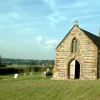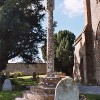When James Scott, Duke of Monmouth, made landfall at Lyme Regis in 1685, it was the curtain-raiser for one of the most bloody and shameful episodes in English history. An illegitimate son of Charles II, the Duke believed himself to be the rightful heir to the Crown, and raised an army in rebellion against the incumbent James II. But the insurrection collapsed, with fatal consequences for the Duke and all those who took up arms in his support. For the revolt could scarcely have been more ill-timed, coming as it did when the Lord Chief Justice in the land was the infamous Baron Sir George Jeffreys of Wem.
Probably the most tragic figure to become ensnared in the judicial reprisal for the rebellion was not one of the numerous renegade soldiers so soon to be hung in gibbets at crossroads the length and breadth of the west country. No, this particular victim of Jeffreys’ indiscriminate brutality was a quiet genteel woman of high standing and humanism, whose only crime was to naively commit the one well-meaning act, which would lead to her downfall. The woman was Dame Alicia (or Alice) Lisle, who earned the unenviable distinction of becoming the first of the accused (and the only woman) to be condemned to death for complicity in the Monmouth Rebellion.
Alice was born Alice Breconsawe (or Breckonshaw) about 1614 and brought up at her family home at Moyles Court, an Elizabethan manor in the parish of Ellingham, just north of Ringwood on the Hants side of the Dorset border. Together with her sister Elizabeth (the future Lady Tipping) she was a daughter of Sir White Breconsawe and Elizabeth Bond. Of the Breconsawe’s next to nothing is known, but on her mother’s side Alice was a descendant of the Purbeck scion of the manorial Bond family of Dorset, whose estate was at Blackmanston.
In 1636 when she was grown up, Alice married John Lisle, a leading Parliamentarian who, under Cromwell, would take up arms against the King in the Civil War. He was called to the bar in 1633 and was MP for Winchester from 1639 and for Southampton in 1654. In 1659/60 he was also Commissioner for the Navy. Lisle was a leading promoter of the trial of Charles I in Westminster Hall in January 1649 and actually drafted the death sentence for the doomed monarch. Later Cromwell appointed Lisle Commissioner of his Seal, and to a place in the House of Lords. By him Alice had four daughters and one son.
The road which would ultimately lead Alice Lisle to her cruel fate began on the battlefield of Sedgemoor, Somerset, in 1685. The Duke of Monmouth, who had declared himself king at Taunton shortly before, was routed at the head of his rebel army by the superior forces of the King, then captured, tried and executed.
Among the Duke’s supporters who would remain at liberty until their eventual capture were two fugitives, one of whom, a man called John Hickes, would later become known to Alice as a wanted man, but not for the reason she supposed. Hickes was a dissenting minister who sent Alice a message asking for shelter at Moyles Court. He arrived at 10pm on July 20th, accompanied by one Richard Nelthorp and Alice, though not believed to be a Monmouth sympathiser, secreted the fugitives in a malthouse. It was there, during a county-wide mopping up sweep of rebel runaways by the King’s men under the command of a Colonel Penruddock (who had been tipped off by a spying villager) that the two men were flushed out the next day, sentenced, then hung, drawn and quartered.
Though Alice Lisle knowingly concealed the wanted man, she mistakenly assumed that John Hickes’ offence was one of religious dissent, not treason. But under Jeffreys’ draconian interpretation of the criminal code, the difference would probably have been academic. Although many more arrests, trials, and executions were to follow in the months ahead, all of these were of male combatants fighting in a rebel army. It is thus a measure of the extraordinary harshness of 17th century justice that, at least in the Lisle case, no concessions were made to the accused’s sex, age, infirmities, or social status. She would go down to her grave along with those far more guilty and deserving of punishment than herself.
As Chief Justice it fell to Jeffreys to try and condemn Alice and the captured rebels as the King’s advocate, under duress to apply harsh retribution for Monmouth’s treason. Many hundreds would be hung; some luckier ones transported – but fewer still would ever be acquitted. Indeed it was said that Jeffreys was a magistrate who never found anyone innocent (though 80 rebels were pardoned.) He was equally deaf to any appeals for clemency. On one notorious occasion at Dorchester a girl saw her brother’s lifeless body hanging from a wall opposite her window the morning after she had pleaded with the judge to spare his life.
For the circuit of trials and summary executions that have passed into history as the Bloody Assizes, Jeffreys embarked upon a veritable tour de force, holding court at Dorchester and elsewhere in the west country. In Dorset’s county town the judge presided in a room at the Antelope Inn, ever after known as the Monmouth Room. Alice Lisle however, was not tried and sentenced at the Antelope, but at a court in Winchester.
Here she was charged with the treasonable act of harbouring two of the King’s enemies. But despite the jury finding her innocent three times, Jeffreys refused to accept the verdict – three times. Still, the bullying judge was very persuasive. After much coercion, and probably fear of their own lives, Jeffreys managed to exact from his jury precisely the verdict he wanted: not one determined so much by the facts or mitigating circumstances, as by a malicious prejudice and paranoid loathing for anyone wishing ill of the monarch!
Then Dame Alice’s fate was sealed. As a woman inevitably found guilty she was first sentenced to be burnt at the stake. But this method of dispatch proved too extreme for the Clergy of Winchester to stomach. Following their intercession to James II, the King commuted the sentence to one of beheading!
It is recorded that the condemned woman spent her last night at the Eclipse Inn in Winchester after delivering a remarkable execution speech apparently recorded for posterity by the court clerk. And the following day, 2nd of September 1685 in Winchester’s market square, Dame Alice Lisle’s head was struck from her body by a swordsman. She was then about 75 years of age and was supposedly buried in the precincts of Ellingham’s 13th century church, although there is some archaeological evidence that the tomb supposed to be hers was occupied by someone else.
By this time however, Sir John Lisle was already dead. At the Restoration in 1660 he fled to Switzerland, but was murdered there by a man called Thomas McDowell in 1664. As for Jeffreys, when the Protestant William III came to the throne, the King, possibly fearing a Papist backlash against the judge, threw him into prison for his own safety in 1688, but he died from kidney failure the following year.



